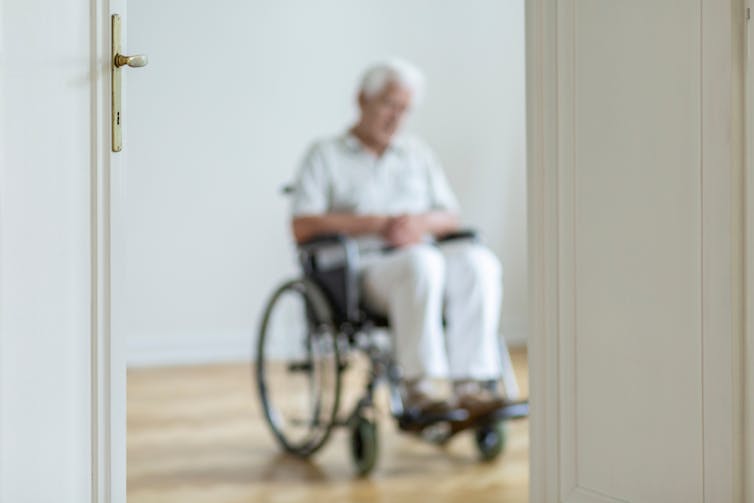The government has thrown another $171 million at the problem. But a real plan for aged care has been missing all along
- Written by Joseph Ibrahim, Professor, Health Law and Ageing Research Unit, Department of Forensic Medicine, Monash University
As deaths in aged care continue to rise, the community may find the Morrison government’s announcement of an additional A$171.5 million to boost its response to COVID-19 in residential aged care reassuring.
The package was agreed by all states and territories at Friday’s National Cabinet meeting, and brings the total Commonwealth funding for aged-care support during the pandemic to more than A$1 billion.
The funding will go towards additional support for the aged-care workforce, the recently established Victorian Aged Care Response Centre, and an Australian Health Protection Principal Committee (AHPPC) Aged Care Advisory Group.
It will also fund grief and trauma support for families, more compliance and quality checks, and support the establishment of emergency response centres in each state and territory.
But this announcement appears to be geared primarily towards dealing with the unfolding disaster wrought by the federal government’s mishandling of the COVID-19 crisis in aged care. It will do little to better prepare the sector for further outbreaks or a third wave.
I would argue we haven’t had clear a plan for residential aged care since the pandemic began.
Read more: 4 steps to avert a full-blown coronavirus disaster in Victoria's aged care homes
What should a plan look like?
While fighting the current fires is important, here are some of the things we would need to see in a truly forward-looking plan for managing COVID-19 in the aged care sector.
A leader
The first step for the Morrison government is to appoint a leader for aged care, who will be accountable and drive a coherent strategy to address the sector’s challenges.
Recent evidence presented to royal commission and senate inquiry hearings highlight there is no one in charge. It’s clearly not the federal Minister for Aged Care and Senior Australians Richard Colbeck.
The person must be apolitical, without ties to peak bodies or providers, and represent the interests of residents and their families. This position could be similar to a chief health officer, but specifically for residential aged care.
 The new funding for aged care will include grief and trauma support for residents and families, among other things.
Shutterstock
The new funding for aged care will include grief and trauma support for residents and families, among other things.
Shutterstock
Clear goals
Second, we need a clear statement describing the goals and overall objectives this plan will achieve. The latest announcement is a scattergun approach, neither coherent nor strategic. It plugs existing holes.
We have a clear, well-presented strategy for reducing community transmission of COVID-19. We should demand an equally clear strategy for aged care. The focus should be on saving lives, while being humane and compassionate to residents, family and aged-care staff.
And we must ensure transparency and accountability by making the plan available to and responding to the public in real time. We need to eliminate the diffusion of responsibilities for the aged-care response across the government, health department and the Aged Care Quality and Safety Commission. It creates confusion and opportunities to excuse inaction, and offers no mechanism to redress failures.
We also need a structured approach for rapid two-way information flow between the people in charge and the people on the ground.
A national taskforce
The third step is a national taskforce with the ability to respond to rapidly changing conditions. The AHPPC Aged Care Advisory Group serves to advise government ministers, but only partially addresses this step.
The group’s composition and selection process ought to be publicly visible. The panel needs people with technical expertise, integrity and without any competing interests. There should be at least two members who are consumers — ideally aged-care residents with a human-rights lawyer to support and advocate on their behalf.
Outbreak preparedness
The fourth step is urgently addressing the aged-care sector’s approach to outbreak preparedness and prevention of COVID-19. We must agree to a set of objective measurement tools to assess the approach taken at a facility, organisational and regional level. Then we must be able to evaluate, support and strengthen those plans.
The Aged Care Quality and Safety Commission was allocated an additional A$9.1 million to increase their compliance and quality checks of individual facilities across the country. But additional checks are worthless if we don’t have uniform, transparent checks and balances across the board.
Supporting the workforce
The fifth step is genuine support for the aged-care workforce. Staff confidence is key to reducing absenteeism in those who are well and presenteeism in those who are unwell.
While the government has directed A$140 million to staff, including for additional surge workforce, increased training, and retention bonus measures, we’re still missing a strategy to retain staff.
Increasing staff confidence and retaining them in the sector, especially in such a tumultuous time, requires asking, listening and responding to aged-care workers’ concerns. Beyond just offering financial incentives, we need to make them feel prepared, safe and that their concerns are addressed.
 We need greater transparency and accountability in the aged care sector.
Shutterstock
We need greater transparency and accountability in the aged care sector.
Shutterstock
Respecting residents and families
The final step is recognising the rights of aged-care residents and their families. An advocate not connected to the aged-care providers or government should have access to every aged-care home to be the eyes and ears for residents and their families. This could be achieved with a workforce of just 300 people, each advocate coordinating with ten aged-care homes.
The recent announcement provides for increased availability of grief and trauma support services, with A$12.5 million allocated to supporting residents and their families who have experienced a COVID-19 outbreak. This fails to recognise all residents and families are likely affected by the pandemic and lockdowns, even if they’re not directly affected by an outbreak.
Similarly, the A$1.5 million allocated to ensure regular direct communication from the health department appears to be only for “families and loved ones of aged-care residents impacted by COVID-19”. Is seems an odd approach as our whole country and every aged-care home is affected by the pandemic.
A coordinated, evidence-based national plan
The federal government’s commitment is a small amount, equating to roughly 1.5% of what this already struggling sector receives annually.
While it’s welcome, the majority of funds are allocated to expand existing initiatives which have had limited success.
Throwing money at a problem is not how we develop a coordinated, evidence-based national plan that addresses the known gaps.
Authors: Joseph Ibrahim, Professor, Health Law and Ageing Research Unit, Department of Forensic Medicine, Monash University





